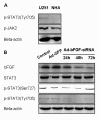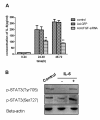Adenovirus-mediated delivery of bFGF small interfering RNA reduces STAT3 phosphorylation and induces the depolarization of mitochondria and apoptosis in glioma cells U251
- PMID: 21906308
- PMCID: PMC3179445
- DOI: 10.1186/1756-9966-30-80
Adenovirus-mediated delivery of bFGF small interfering RNA reduces STAT3 phosphorylation and induces the depolarization of mitochondria and apoptosis in glioma cells U251
Abstract
Glioblastoma multiforme (GBM) carries a dismal prognosis primarily due to its aggressive proliferation in the brain regulated by complex molecular mechanisms. One promising molecular target in GBM is over-expressed basic fibroblast growth factor (bFGF), which has been correlated with growth, progression, and vascularity of human malignant gliomas. Previously, we reported significant antitumor effects of an adenovirus-vector carrying bFGF small interfering RNA (Ad-bFGF-siRNA) in glioma in vivo and in vitro. However, its mechanisms are unknown. Signal transducer and activator of transcription 3 (STAT3) is constitutively active in GBM and correlates positively with the glioma grades. In addition, as a specific transcription factor, STAT3 serves as the convergent point of various signaling pathways activated by multiple growth factors and/or cytokines. Therefore, we hypothesized that the proliferation inhibition and apoptosis induction by Ad-bFGF-siRNA may result from the interruption of STAT3 phosphorylation. In the current study, we found that in glioma cells U251, Ad-bFGF-siRNA impedes the activation of ERK1/2 and JAK2, but not Src, decreases IL-6 secretion, reduces STAT3 phosphorylation, decreases the levels of downstream molecules CyclinD1 and Bcl-xl, and ultimately results in the collapse of mitochondrial membrane potentials as well as the induction of mitochondrial-related apoptosis. Our results offer a potential mechanism for using Ad-bFGF-siRNA as a gene therapy for glioma. To our knowledge, it is the first time that the bFGF knockdown using adenovirus-mediated delivery of bFGF siRNA and its potential underlying mechanisms are reported. Therefore, this finding may open new avenues for developing novel treatments against GBM.
Figures




Similar articles
-
Blocking the bFGF/STAT3 interaction through specific signaling pathways induces apoptosis in glioblastoma cells.J Neurooncol. 2014 Oct;120(1):33-41. doi: 10.1007/s11060-014-1529-8. Epub 2014 Jul 22. J Neurooncol. 2014. PMID: 25048528
-
Adenovirus-mediated transfer of siRNA against basic fibroblast growth factor mRNA enhances the sensitivity of glioblastoma cells to chemotherapy.Med Oncol. 2011 Mar;28(1):24-30. doi: 10.1007/s12032-010-9445-z. Epub 2010 Feb 24. Med Oncol. 2011. PMID: 20221717
-
Adenovirus-mediated delivery of bFGF small interfering RNA increases levels of connexin 43 in the glioma cell line, U251.J Exp Clin Cancer Res. 2010 Jan 14;29(1):3. doi: 10.1186/1756-9966-29-3. J Exp Clin Cancer Res. 2010. PMID: 20074329 Free PMC article.
-
The role of Stat3 in glioblastoma multiforme.J Clin Neurosci. 2013 Jul;20(7):907-11. doi: 10.1016/j.jocn.2013.03.006. Epub 2013 May 17. J Clin Neurosci. 2013. PMID: 23688441 Review.
-
Signal transducer and activator of transcription-3: a molecular hub for signaling pathways in gliomas.Mol Cancer Res. 2008 May;6(5):675-84. doi: 10.1158/1541-7786.MCR-07-2180. Mol Cancer Res. 2008. PMID: 18505913 Free PMC article. Review.
Cited by
-
The role of STAT3 activation in modulating the immune microenvironment of GBM.J Neurooncol. 2012 Dec;110(3):359-68. doi: 10.1007/s11060-012-0981-6. Epub 2012 Oct 25. J Neurooncol. 2012. PMID: 23096132 Free PMC article.
-
The role of STAT3 in leading the crosstalk between human cancers and the immune system.Cancer Lett. 2018 Feb 28;415:117-128. doi: 10.1016/j.canlet.2017.12.003. Epub 2017 Dec 6. Cancer Lett. 2018. PMID: 29222039 Free PMC article. Review.
-
Physalis alkekengi var. franchetii Extracts Exert Antitumor Effects on Non-Small Cell Lung Cancer and Multiple Myeloma by Inhibiting STAT3 Signaling.Onco Targets Ther. 2021 Jan 12;14:301-314. doi: 10.2147/OTT.S282334. eCollection 2021. Onco Targets Ther. 2021. PMID: 33469308 Free PMC article.
-
A critical overview of long non-coding RNA in glioma etiology 2016: an update.Tumour Biol. 2016 Nov;37(11):14403-14413. doi: 10.1007/s13277-016-5307-4. Epub 2016 Sep 15. Tumour Biol. 2016. PMID: 27629290 Review.
-
MiRNA-mediated tumor specific delivery of TRAIL reduced glioma growth.J Neurooncol. 2013 Mar;112(1):27-37. doi: 10.1007/s11060-012-1033-y. Epub 2013 Jan 22. J Neurooncol. 2013. PMID: 23338605
References
-
- Miller CR, Perry A. Glioblastoma. Arch Pathol Lab Med. 2007;131:397–406. - PubMed
Publication types
MeSH terms
Substances
LinkOut - more resources
Full Text Sources
Medical
Molecular Biology Databases
Research Materials
Miscellaneous

